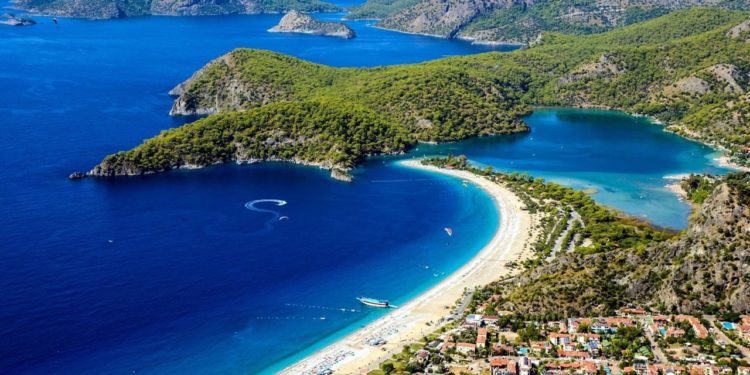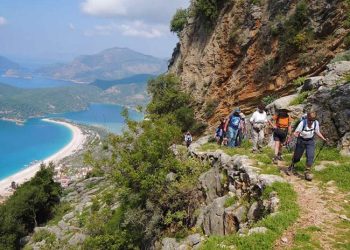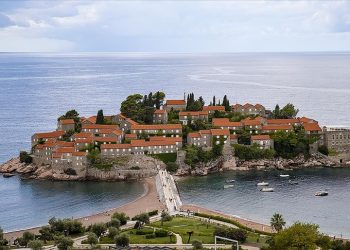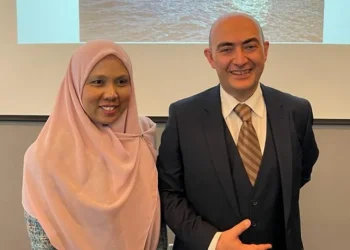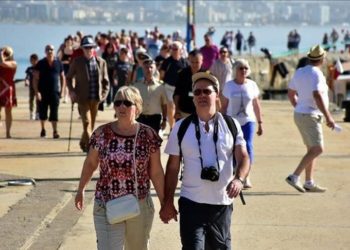Fethiye, which is one of the regions that local and foreign tourists are most curious about, has historical beauties as well as natural beauties. There are so many beautiful places to discover in Fethiye that it allows you to have both a summer holiday and a cultural holiday.
Fethiye, which is a great route for holiday planning, is a region where you can admire the unique beauties of the sea and nature. Here, you can dominate the sunrise and the sunset with a different beauty. Resting on the beaches after a historical tour, spending time among the greenery after the action on the mountain slopes, all these cause you to explore this city with admiration. Let’s examine together where you should explore and where you should jump from the hot sands to the cool waters.
Fethiye Attractions
First of all, we recommend you to see the Amintas King’s Tomb, as there are mausoleums that make this city another privilege. Telmessos Amphitheater, which belongs to the Early Roman Period, Kayaköy and Paspatur, one of the first settlements, are among the points you should include in your cultural tour. We can direct those who want to reward themselves after cultural exploration to Ölüdeniz, Butterfly Valley, Saklıkent and Calis Beach. For those who do not want to go on a trip to Fethiye without examining the historical and cultural details of the city, we definitely recommend you to see the Fethiye Museum.
Amints King Tombs
The Amintas King Tombs in Telmessos Ancient City offer us the opportunity to explore all the details of the period. The king tombs, located on the slope of the city, are made in the Ionic style and have two columned facades. This magnificent mausoleum was built in the 4th century in the name of Amintas, the son of Hermapias. An inscription at the entrance of the tomb draws attention. This article is named after world famous traveler Charles Texier. Texier carved his name on the entrance of the tomb during his visit to the region in 1850. The king tombs carved into the rocks will be the most magnificent and interesting part of your Fethiye trip. You can visit the Amintas King Tombs, which consist of imposing columns that the Telmsessos Ancient City has brought to the present day, between 09:00 and 20:00.
Telmessos Amphitheater
Telmessos Amphitheater is the oldest theater in Turkey near the sea. The Telmessos Amphitheater, which emerged as a result of archaeological excavations, is one of the structures from the Early Roman Period. The amphitheater with a capacity of 5,000 people was used as an arena during the Byzantine Period. The theater area, which was built in the Hellenistic period, was damaged in earthquakes and was rebuilt in the 2nd century with the style of the Roman Period. We strongly recommend you to visit the amphitheater, which offers observing, which attracts attention with its historical details as well as its natural beauty.
Kayakoy
Kayaköy, one of the first settlements dating back to 3000 BC, was an old Greek settlement. Since the Greeks were very knowledgeable and careful about agriculture, they would not build houses in areas suitable for planting and planting. At that time, houses were built on rocky areas and slopes. The population of this village, where approximately 30 thousand people lived in the 1900s, decreased considerably after the population exchange after the War of Independence. After the war, most of the people immigrated to Greece. Currently, there are still people living in the village. Afterwards, houses were started to be built on the flat area in the village and a settlement area was created on its own. Almost all of the old houses are under protection. When you come to Kayaköy, it is not possible to return without seeing Soğuksu Bay. At the end of the road filled with stone pavements, you can reach the perfect view of Soğuksu Bay from the hill. We recommend you to see this bay, which will bring you to yourself from the heat of summer with its coolness, even for refreshment. From here, you can reach Ölüdeniz on foot to swim in the sea.
Paspatur
Paspatur, which is one of the oldest settlements in Fethiye, means Old City. It is very easy in terms of transportation with its proximity to Fethiye Marina. Every year, thousands of people do not end their Fethiye trip without visiting this place. The most striking thing in Paspatur Bazaar, which consists of several streets, is the wooden bay windows. You can’t help yourself from shooting these houses, which will have the most colorful and authentic moments of your photos. After your long walk in the bazaar, you can enter the Fethiye Hamam, which will welcome you, and you can relieve the tiredness of a whole day with pleasure. Paspatur Mosque, located in Sarsin, is the oldest structure belonging to the Ottoman period. Another detail that makes Paspatur special is the aqueduct passing through the middle of the bazaar. According to one of the rumors, it is said that those who came to Fethiye and drank Paspatur water could not leave this city easily, but came again in a short time.
Oludeniz – Where is Oludeniz?
Ölüdeniz is a neighborhood in the Fethiye district of Muğla province, located in the Aegean Region, in the southwest of Turkey. The neighborhood is 14 kilometers from Fethiye town centre.
How to go to Ölüdeniz?
Intercity buses can be preferred to reach Ölüdeniz by road. In addition to big cities such as Istanbul, Ankara, Izmir, Bursa and Antalya, there are flights to Fethiye from many points in Turkey. From Fethiye bus station, you can take the minibuses that depart every few minutes to go to Ölüdeniz.
The closest airport to Ölüdeniz is Dalaman Airport, 65 kilometers away. It is possible to reach Ölüdeniz from Dalaman, one of the largest airports in the world, by rental car or by the vehicles of transfer companies. Antalya Airport is 2 hours and 30 minutes away from Ölüdeniz. You can reach Ölüdeniz by buses that serve frequently from the center of Antalya.
Butterfly Valley / Kelebekler Vadisi
Butterfly Valley, located in Ölüdeniz town of Fethiye district of Muğla, is a region that is almost a treasure with its natural assets. The Butterfly Valley, surrounded by steep cliffs reaching 350 meters, is located on the skirts of Babadağ, which attracts attention with its endemic plant species. The region, which is named Butterfly Valley due to the habitat of more than 80 butterfly species and tiger butterflies, is less affected by pollution because it is away from the outside world by means of the sea and high cliffs. In addition, the contribution of businesses and conservation efforts in the Valley keeps the natural life alive. In this way, the butterfly population is higher than in other regions.
The history of Butterfly Valley dates back to 400 BC. During the Lycian period, Perdicia settlement was established just behind the hills of the Valley. Starting from the Byzantine and Greek civilizations to the last periods of the Ottoman Empire, gardening by establishing terraces on the slopes is a tradition that has continued until today. The first touristic business in Butterfly Valley was established in 1987. In the 1960s, Vadi was sold to various individuals by tender. An agricultural engineer who bought this place cut down huge mulberry, citrus and various fruit trees on the grounds that it was old. He planned to plant saplings here with the thought that it would be more productive and with the intention of making a lot of profit in a short time, but he could not cope with the overseas location of the Valley and left it without a tree. The valley was founded in 1987 by S.S. With the efforts of the Anatolian Tourism Development Cooperative, afforestation, vineyards and gardens were created despite the mountain goats. Thus, the Butterfly Valley has gained the quality of a natural paradise, as can be seen today.
Butterfly Valley is one of the coves such as Ölüdeniz, Kıdrak and Kabak located on the skirts of Babadağ, which is shown by the World Heritage Conservation Foundation among the 100 mountains that attract attention with its endemic plant species and need to be protected. These mountains and bays, which are very valuable in terms of natural wealth, have been declared a legal protection (site) area by the Cultural and Natural Heritage Preservation Board. Thus, it is not possible to build any structure in the region. Accommodation can be made in the valley with bungalows and camping tents.
Butterfly Valley stays away from the negative effects of mass tourism with protection measures. The principles of the business in the Valley to focus on ecological agriculture, ecological tourism, culture, art and sports activities increase the qualities of the Valley. Among the plant species in the Valley, where permaculture is practiced in some parts, there are self-growing species such as thyme, laurel, oleander, chasteberry, sour pomegranate, wild grape, carob, black tree, olive, centaury, devil’s grass.
Climate of Butterfly Valley
The climatic conditions of the valley differ from the seasonal conditions. The sweltering summer heat of the Mediterranean climate does not hit the Valley. The breezes blowing during the day and the air current blowing from the mountains at night have a relaxing and cooling effect. The autumn season is experienced like summer, and the air flow from the sea in the winter season softens the air. The frost event, which can be seen several times a year and can even hit Fethiye, does not affect the Valley. Watching the stream that cuts through the beach and pours into the sea in the spring is considered a unique experience.
When to go to Butterfly Valley?
It is not possible to stay in the Valley except for the service period offered by the Valley management. The water and electricity energy of the region is provided by the enterprise, not the state.
How to Get to Butterfly Valley?
It is possible to reach the Butterfly Valley by road, boat and air due to the airport located nearby.
The closest airport to Butterfly Valley is Dalaman, 55 kilometers from Fethiye. Many flights are organized in Dalaman from Turkey and abroad.
In order to reach by road, it is necessary to come to Fethiye first. There are bus services to Fethiye from many cities of Turkey. In order to reach the Valley from Fethiye, first of all, it is necessary to go to Ölüdeniz with the minibuses departing in front of the bus station. Butterfly Valley can be reached by using the boat services from Ölüdeniz to the Valley. Zodiac boat services can be obtained by calling Vadi outside of the service hours.
You can reach the valley from Ölüdeniz by boat. Boat fees are 30 TL per person for round trip. The journey takes approximately 30 minutes. Care should be taken to buy tickets from within the boat, not on land. Otherwise, fake tickets may be purchased.
Hidden City / Saklıkent
Saklıkent is a canyon located in the Saklıkent National Park in the south of the Republic of Turkey, in Antalya’s Kaş and Muğla’s Fethiye districts. The canyon is located in Fethiye’s Foça District. The canyon formed by Karaçay, a tributary of Eşen Stream, is approximately 200 kilometers from Antalya, 46 kilometers from Fethiye and 64 kilometers from Kaş.
Information About Saklikent Canyon
Since Saklıkent Canyon is filled with water with a high flow rate, it is not possible to enter the water. A 200-meter wooden bridge suspended from the steep slopes of the canyon with iron bars is used for the passage and entrance. Karst springs, which are quite cold after the bridge, appear before you.
The area is also used as a picnic spot in the summer, and an average of 180 to 210 thousand tourists visit it annually. The area around the canyon was declared Saklıkent National Park with the Official Gazette dated 06.06.1996 and taken under protection. There are also three villages of Kaş and Fethiye within this national park area. It is possible to see Maquis, Red Pine, Black Pine and Cedar communities in the area according to plant varieties and height.
Calis Beach
Calis Beach is a beach where you can’t take your eyes off with its flawless beauty. Calis Beach, which is 3 kilometers away from the center of Fethiye, ranks first among the clearest and most beautiful beaches to swim in. The beach not only offers you a wonderful sea, but there are also bars and restaurants where you can have a lot of fun after getting out of the sea. There are also hotels where you can stay. Do not be surprised if you see the water cloudy because the sea is very wavy compared to Ölüdeniz. Calis Beach, where nightlife is the most colorful, has an ambiance where you can spend your whole day pleasant with its long beach and promenade.
12 Islands
This region, which consists of the Kapıdağ Peninsula and islands, which you can admire, decorated with many coves, is colored in the most beautiful hours of the summer with daily boat tours. Boat tours departing from Fethiye and Göcek allow you to see Yassıca Islands, Hamam Bay, Kurşunlu Bay, Yavansu, Bedri Rahmi Bay, Shipyard Island, Göbün Bay, Boynuzbükü, Göcek Island, Domuz Island, Zeytin Island and Kızıl Island in one go. . Since you will see the most beautiful colors of the bay, the 12 Islands boat tour is one of the most ideal activities for holidaymakers who want to spend a fun day.
Fethiye Museum
Fethiye Museum is an archeology museum that allows you to witness all the details of Fethiye history. When you come to Fethiye, which has hosted many civilizations with its history dating back to 3000 BC, you should definitely visit the museum. In the museum, you can examine works consisting of sculptures, ceramics, statue heads, glass, metal and circuses that existed until after the Byzantine Period. In addition, historical remains from the nearby ruins are also exhibited in this museum. In the museum, there are interesting artifacts from the Hellenistic Period, Roman Period, Bronze and Archaic Period, especially the Ottoman Empire, which were obtained as a result of ecological excavations. The museum, which is open every day of the week, is open between 08.00-17.00 in the winter months and between 08.00-19.00 in the summer months.

